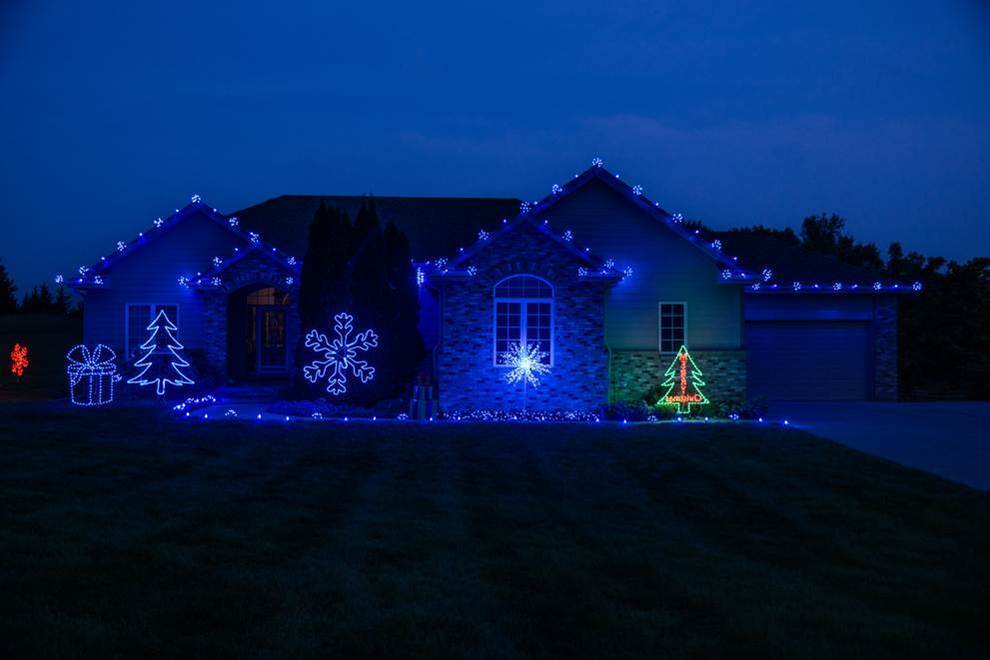-Jun-05-2024-09-42-35-8478-PM.png?width=800&height=418&name=Blog%20Post%20Image%20Size%20(3)-Jun-05-2024-09-42-35-8478-PM.png)
Have you ever painted a room, only to find that the color looks completely different from what you envisioned? Whether you hire a painter for the project or are doing it yourself, it’s a common issue for homeowners in Omaha. You pick a beautiful shade of blue for your living room, but under your home’s lighting, it looks more like a dull gray. This can be frustrating and can turn an exciting home improvement project into a disappointing experience.
At Brush & Roll Painting, with years of experience painting homes across Omaha, we understand the intricate relationship between lighting and paint colors. With our certified color consultants and a local designer, we help guide homeowners to make the best choices for their homes, ensuring that the colors they choose look just as stunning on their walls as they do on the paint swatch.
In this article, we’ll explain how different types of lighting affect paint colors in your home. We’ll dive into specifics about various light bulbs like LEDs, discuss how certain colors are more affected by lighting, and explore which rooms are most impacted. By the end of this article, you’ll have a clear understanding of how to choose the right paint colors and lighting to achieve the perfect look in your home.
Understanding Light and Paint Colors
Before we delve into specifics, it’s essential to understand the basics of how light affects color. The color you see on your walls is a result of light reflecting off the paint. Different types of light can change the way colors appear because they have different color temperatures and intensities.
 Natural Lighting
Natural Lighting
Natural light varies throughout the day and changes with the seasons. Morning light tends to be softer and cooler, while midday light is bright and more neutral. Evening light can add a warm, golden glow to your rooms.
North-facing rooms generally receive cooler, softer light, making colors appear more subdued. South-facing rooms get the most intense, direct light, which can make colors appear more vibrant.
Artificial Lighting
Artificial lighting can be broadly categorized into incandescent, fluorescent, and LED lighting. Each type of light bulb has unique characteristics that influence how paint colors appear on your walls.
Incandescent Bulbs
Incandescent bulbs put off a warm, yellow light. They tend to enhance warm colors like reds, oranges, and yellows while making cool colors like blues and greens appear duller. These bulbs are less energy-efficient and are becoming less common, but they are still used in many homes.
Fluorescent Bulbs
Fluorescent lighting can vary significantly in color temperature. Cool white fluorescents emit a blue-tinted light that can make warm colors look flat and uninviting. On the other hand, warm white fluorescents emit light closer to that of incandescent bulbs, enhancing warm colors and making cool colors appear more muted.
LED Bulbs
LEDs are highly versatile and come in a wide range of color temperatures, from warm white to cool daylight. Warm white LEDs are similar to incandescent bulbs, enhancing warm colors. Cool white LEDs can make a room feel more modern but can also make warm colors appear washed out. Daylight LEDs, which mimic natural light, are great for showcasing true colors but can be too harsh for some spaces.
Impact of Lighting on Different Paint Colors
Not all paint colors are affected equally by lighting. Here’s how various hues respond to different lighting conditions:
-Jun-05-2024-09-40-12-7404-PM.png?width=590&height=308&name=Blog%20Post%20Image%20Size%20(1)-Jun-05-2024-09-40-12-7404-PM.png) White and Neutral Paint Shades
White and Neutral Paint Shades
White and neutral colors are highly reflective and can take on the characteristics of the light source. Under warm lighting, they can appear creamy or yellowish, while under cool lighting, they can look stark and cold.
Blues and Green Paint Shades
Blues and greens are cool colors that can be significantly affected by the type of lighting. Warm lighting can make these colors look muted or even grayish. Cool lighting, on the other hand, enhances their crispness and vibrancy.
Reds, Oranges, and Yellow Paint Shades
Warm colors like reds, oranges, and yellows are generally enhanced by warm lighting, making them appear more intense and inviting. Cool lighting can make these colors seem duller and less vibrant.
Purple Paint Shades
Purples, which are a mix of red and blue, can be tricky. They can look rich and royal under warm lighting but can appear more blue or gray under cool lighting.
Lighting in Different Rooms
Different rooms in your home serve different purposes, and the lighting in these spaces should complement their function while enhancing the paint colors.
 Living Rooms and Bedroom Lighting
Living Rooms and Bedroom Lighting
These rooms are often used for relaxation and leisure. Warm lighting is generally preferred as it creates a cozy and inviting atmosphere. Warm white LEDs or incandescent bulbs can enhance warm paint colors, making the space more comfortable.
Kitchens and Bathroom Lighting
These spaces require brighter, more functional lighting. Cool white or daylight LEDs are ideal as they provide clear, bright light that makes tasks easier. However, be mindful of the paint colors. Cool lighting can make warm colors look less appealing, so consider neutral or cool-toned paint for these areas.
.jpg?width=481&height=361&name=Georges%20After%204%20(1).jpg) Home Office Lighting
Home Office Lighting
For productivity, daylight LEDs are an excellent choice as they mimic natural light and reduce eye strain. Neutral or cool-toned paint colors work well in these environments, as they remain true under bright lighting.
Chandeliers vs. Ceiling Lights
The type of light fixture also plays a role in how colors appear. Chandeliers, which often use multiple bulbs, can provide a softer, more diffused light, enhancing warm tones and creating a more inviting atmosphere. Ceiling lights, especially recessed lighting, provide direct, focused light that can highlight specific areas of a room but might create shadows that affect color perception.
Choosing the Right Lighting & Paint Shade Combination
-Jun-05-2024-09-37-02-0996-PM.png?width=565&height=295&name=Blog%20Post%20Image%20Size%20(2)-Jun-05-2024-09-37-02-0996-PM.png)
When selecting paint colors and lighting for your home, it’s essential to consider how they will work together. Here are some actionable steps:
-
Get a Color Consultation: Consider getting a color consultation with a certified consultant or a designer. These professionals can help you choose the perfect shades and lighting combinations to enhance your home’s beauty.
-
Test Paint Samples: Always test paint samples on your walls and observe them under different lighting conditions throughout the day.
-
Choose the Right Bulbs: Select bulbs that complement the paint colors you’ve chosen. For warm colors, opt for warm white LEDs or incandescent bulbs. For cool colors, cool white or daylight LEDs are better.
-
Layer Lighting: Use a combination of ambient, task, and accent lighting to create a balanced and flexible ambiance.
-
Ambient Lighting: Ambient lighting, also known as general lighting, provides an overall illumination to a room. It’s the primary source of light and sets the tone for the space. This type of lighting is essential for ensuring that the room is well-lit and comfortable to be in. Example: ceiling light, fan, or chandelier.
-
Task Lighting: Task lighting is focused lighting that helps you perform specific tasks such as reading, cooking, or working. It’s brighter than ambient lighting and is directed to where it’s needed the most. Example: a lamp or under-cabinet lighting.
-
-
- Accent Lighting: Accent lighting is used to highlight specific features or areas within a room, adding depth and visual interest. It’s typically brighter than ambient lighting but not as intense as task lighting. Accent lighting draws attention to particular objects or architectural elements. Example: LED color lights along a bookshelf.
5. Consider Room Function: Tailor your lighting and paint choices to the specific needs of each room, ensuring both functionality and aesthetic appeal.
Home Lighting vs Interior Paint Shades
Choosing the right paint color for your home can be challenging, especially when lighting plays such a significant role in how colors appear.
Understanding the relationship between lighting and paint colors can help you avoid picking the wrong shade or lightbulb and achieve the perfect look for your space. By testing paint samples, selecting the appropriate light bulbs, considering the function of each room, and seeking advice from a certified color consultant or designer, you can create a beautiful home environment you love.
At Brush & Roll Painting, we’ve guided countless homeowners in Omaha since 1996 through the process of picking the perfect shade and providing a high-quality paint job that lasts.
Interior painting projects can be stressful, especially picking the perfect shade. Next, download your interior painting project checklist so you can be confident in every step of the process, whether you do the project yourself or hire a professional painting company in Omaha.
Kaylea is the Brush & Roll Painting Content Manager. Kaylea is a Journalism and Media Communications summa cum laude graduate with a minor in Marketing from the University of Nebraska at Omaha. Kaylea manages the marketing for Brush & Roll Painting.


-Jun-05-2024-09-43-33-0455-PM.png?width=582&height=304&name=Blog%20Post%20Image%20Size%20(4)-Jun-05-2024-09-43-33-0455-PM.png)

















-Jul-23-2025-02-21-33-5468-PM.png?width=800&height=418&name=Blog%20Post%20Image%20Size%20(2)-Jul-23-2025-02-21-33-5468-PM.png)




-Oct-22-2025-01-39-19-5208-PM.png?width=800&height=418&name=Blog%20Post%20Image%20Size%20(1)-Oct-22-2025-01-39-19-5208-PM.png)


